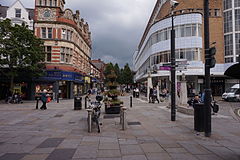Doncaster, South Yorkshire
| Doncaster | |
|---|---|
 St Sepulchre Gate and Printing Office Street junction in Doncaster town centre |
|
| Doncaster shown within South Yorkshire | |
| Population | 109,805 (2011 Census) |
| OS grid reference | SE5702 |
| Metropolitan borough | |
| Metropolitan county | |
| Region | |
| Country | England |
| Sovereign state | United Kingdom |
| Post town | DONCASTER |
| Postcode district | DN1-DN12 |
| Dialling code | 01302 |
| Police | South Yorkshire |
| Fire | South Yorkshire |
| Ambulance | Yorkshire |
| EU Parliament | Yorkshire and the Humber |
| UK Parliament | |
| Website | Doncaster Council |
Doncaster (/ˈdɒŋkəstər/ or /ˈdɒŋkæstər/) is a large market town in South Yorkshire, England. Together with its surrounding suburbs and settlements, the town forms part of the Metropolitan Borough of Doncaster, which had a mid-2016 est. population of 306,400. The town itself has a population of 109,805. The Doncaster Urban Area had a population of 158,141 in 2011 and includes Doncaster and neighbouring small villages. Historically part of the West Riding of Yorkshire until 1974, Doncaster is about 17 miles (30 km) north-east of Sheffield, with which it is served jointly by an international airport, Doncaster Sheffield Airport in Finningley. The metropolitan boroughs of Barnsley, as the county town, Doncaster, and Rotherham, were created in 1974, and incorporated with the city of Sheffield into the metropolitan county of South Yorkshire.
Possibly inhabited by earlier people, Doncaster grew up at the site of a Roman fort constructed in the 1st century at a crossing of the River Don. The 2nd century Antonine Itinerary and the early 5th century Notitia Dignitatum (Register of Dignitaries) called this fort Danum. The first section of the road to the Doncaster fort had probably been constructed since the early 50s, while a route through the north Derbyshire hills was opened in the latter half of the 1st century, possibly by Governor Gn. Julius Agricola during the late 70s. Doncaster provided an alternative direct land route between Lincoln and York. The main route between Lincoln and York was Ermine Street, which required parties to break into smaller units to cross the Humber in boats. As this was not always practical, the Romans considered Doncaster to be an important staging post. The Roman road through Doncaster appears on two routes recorded in the Antonine Itinerary. The itinerary include the same section of road between Lincoln and York, and list three stations along the route between these two coloniae. Routes 7 and 8 (Iter VII & VIII) are entitled "the route from York to London".
...
Wikipedia

